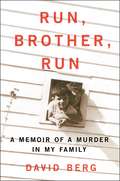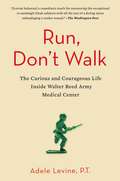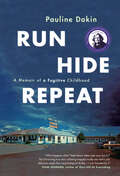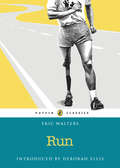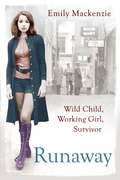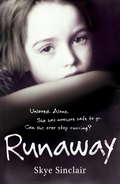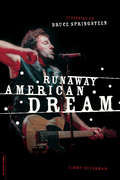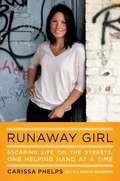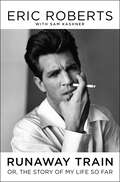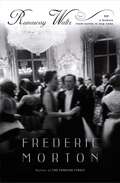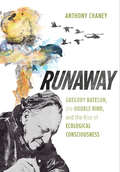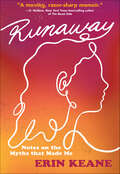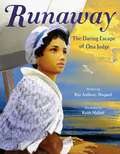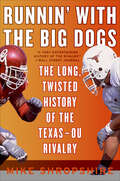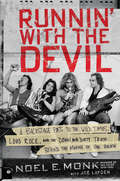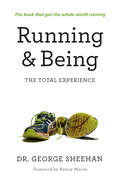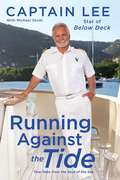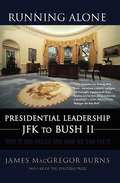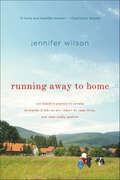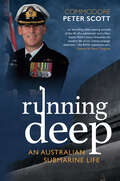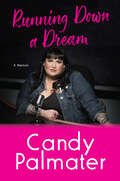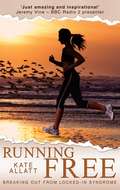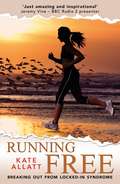- Table View
- List View
Run, Brother, Run: A Memoir of a Murder in My Family
by David BergA searing family memoir, hailed as "remarkable" (The New York Times), "compelling" (People), and "engrossing" (Kirkus Reviews), of a trial lawyer's tempestuous boyhood in Texas that led to the vicious murder of his brother by the father of actor Woody Harrelson.In 1968, David Berg's brother, Alan, was murdered by Charles Harrelson, a notorious hit man and father of Woody Harrelson. Alan was only thirty-one when he disappeared (David was twenty-six) and for more than six months his family did not know what had happened to him--until his remains were found in a ditch in Texas. There was an eyewitness to the murder: Charles Harrelson's girlfriend, who agreed to testify. For his defense, Harrelson hired Percy Foreman, then the most famous criminal lawyer in America. Despite the overwhelming evidence against him, Harrelson was acquitted. After burying his brother all those years ago, David Berg rarely talked about him. Yet in 2008 he began to remember and research Alan's life and death. The result is Run, Brother, Run: part memoir--about growing up Jewish in 1950s Texas and Arkansas--and part legal story, informed by Berg's experience as a seasoned lawyer. Writing with cold-eyed grief and a wild, lacerating humor, Berg tells us first about the striving Jewish family that created Alan Berg and set him on a course for self-destruction, and then about the miscarriage of justice when Berg's murderer was acquitted. David Berg brings us a painful family history, a portrait of an iconic American place, and a true-crime courtroom murder drama that "elegantly brings to life the rough-and-tumble boomtown that was 1960s-era Houston, and conveys with unflinching force the emotional damage his brother's death did to his family" (The New York Times).
Run, Don't Walk
by Adele LevineM*A*S*H meets Scrubs in a sharply observant, darkly funny, and totally unique debut memoir from physical therapist Adele Levine. In her six years at Walter Reed Army Medical Center, Adele Levine rehabilitated soldiers admitted in worse and worse shape. As body armor and advanced trauma care helped save the lives--if not the limbs--of American soldiers fighting in Afghanistan and Iraq, Walter Reed quickly became the world leader in amputee rehabilitation. But no matter the injury, physical therapy began the moment the soldiers emerged from surgery. Days at Walter Reed were intense, chaotic, consuming, and heartbreaking, but they were also filled with camaraderie and humor. Working in a glassed-in fishbowl gymnasium, Levine, her colleagues, and their combat-injured patients were on display at every moment to tour groups, politicians, and celebrities. Some would shudder openly at the sight--but inside the glass and out of earshot, the PTs and the patients cracked jokes, played pranks, and compared stumps. With dazzling storytelling, Run, Don't Walk introduces a motley array of oddball characters including: Jim, a retired lieutenant-colonel who stays up late at night baking cake after cake, and the militant dietitian who is always after him; a surgeon who only speaks in farm analogies; a therapy dog gone rogue; --and Levine's toughest patient, the wild, defiant Cosmo, who comes in with one leg amputated and his other leg shattered. Entertaining, engrossing, and ultimately inspiring, Run, Don't Walk is a fascinating look into a hidden world.
Run, Hide, Repeat: A Memoir of a Fugitive Childhood
by Pauline DakinAn unforgettable family tale of deception and betrayal, love and forgivenessPauline Dakin spent her childhood on the run. Without warning, her mother twice uprooted her and her brother, moving thousands of miles away from family and friends. Disturbing events interrupt their outwardly normal life: break-ins, car thefts, even physical attacks on a family friend. Many years later, her mother finally revealed they'd been running from the Mafia and were receiving protection from a covert anti-organized crime task force. But the truth was even more bizarre. Gradually, Dakin's fears give way to suspicion. She puts her journalistic training to work and discovers that the Mafia threat was actually an elaborate web of lies. As she revisits her past, Dakin uncovers the human capacity for betrayal and deception, and the power of love to forgive. Run, Hide, Repeat is a memoir of a childhood steeped in unexplained fear and menace. Gripping and suspenseful, it moves from Dakin's uneasy acceptance of her family's dire situation to bewildered anger. As compelling and twisted as a thriller, Run Hide Repeat is an unforgettable portrait of a family under threat, and the resilience of family bonds.
Run: Puffin Classics Edition
by Eric WaltersIn conjunction with the Terry Fox Foundation, award-winning author Eric Walters brings Terry Fox and the Marathon of Hope to life for a whole new generation of young readers This first book for young readers about Terry Fox and the Marathon of Hope, written by one of Canada&’s best-known writers for young adults, is a blending of fact and fiction, fully endorsed by The Terry Fox Foundation. Hundreds of thousands of young Canadians participate in the Terry Fox Run each year and this book will further enhance their knowledge of Terry&’s epic journey. Run introduces a national hero to a new generation of readers. In his trademark page-turning style, Eric Walters, bestselling author of Trapped in Ice and Camp X, tells the story of Winston MacDonald. In trouble again after a suspension from school and a runaway attempt, Winston is sent to spend time with his father—a journalist who hasn&’t been around much since his family split up a year ago. Travelling to Nova Scotia with his father, who is covering what he thinks is just a human interest story about a man trying to run across the country, Winston spends a day with Terry Fox and his best friend, Doug. Their determination to achieve what seems like an impossible goal makes a big impression on Winston, and he takes courage and inspiration from Terry&’s run. He is overjoyed when his father&’s article about the Marathon of Hope ignites public interest across the country. But when Winston discovers that his father&’s next article about the Marathon of Hope will characterize Terry and Doug in an unflattering way, he is furious with his father and fearful of betraying his friends. Unsure of what to do or where to turn, Winston decides it is time to make a run for it himself...
Runaway
by Emily MackenzieBeaten by her mother and whipped by her stepfather, Emily eventually finds her way into the care system at the age of twelve, and has an abortion after being gang-raped at thirteen. Continuously abused in a sequence of homes, she runs away at sixteen, becomes a prostitute in Soho, and convinces herself she is being punished for killing her baby. But it was never meant to be like that. Adopted at birth in 1956 by a middle-class family, Emily shares a golden childhood with her adopted sister, attends private schools, and shows a flair for singing and dancing. Things soon change when Emily's jealous mother comes to regard her as her rival. A bored and restless woman, she beats Emily for the first time at age seven and becomes addicted to inflicting pain. Despite Emily's father's attempts to protect her, the parental rows grow more malicious, until her mother finally moves out and, shockingly, wins custody of the children. She remarries a narcissistic widower with alcohol problems and a desire to relive the youth he lost suffering injuries in World War Two. The abuse from her sadistic mother and stepfather intensifies until, against her father's will, Emily's mother puts her into voluntary care. Here Emily enters the toxic spiral of remand homes, psychiatric hospitals, sleeping rough and further sadomasochistic abuse. Set principally between 1966 and 1972, I Just Want To Go Home captures the changing attitudes of the period, socially, morally, politically, but also in regard to the approach of adults and institutions towards the care of children.
Runaway
by Skye SinclairSkye's story is one of survival against the odds. Abandoned by her mother at the age of four and placed in a series of horrible institutions, she learnt to fend for herself from an early age. After a horrific rape when she was ten, she ran from the care home and went to live with the gypsies in the New Forest. She always yearned for freedom and was fearless and impulsive. Her curiosity took her all over the world -- from the abattoirs of France at the age of 15 to the dizzy heights of the Paris fashion world, onto the underbelly of Amsterdam where she became a diamond smuggler at the age of 17 and then to the film studios of Hollywood where she worked as a stunt woman on films like Blues Brothers. Her life took a very different turn when she moved to the island of Phuket in Thailand, adopted four children from different backgrounds, Angelia Jolie-style, and started to sponsor another three. With a group of friends she helped set up an orphanage for street children in neighbouring Cambodia who were eking out a miserable existence on one of the municipal rubbish dumps in Pnom Phen.At the age of 45 her life revolves around children, both her own four and the Cambodians she has pledged to help. The runaway street child has fianlly found a reason to stop running.
Runaway
by Skye SinclairSkye's story is one of survival against the odds. Abandoned by her mother at the age of four and placed in a series of horrible institutions, she learnt to fend for herself from an early age. After a horrific rape when she was ten, she ran from the care home and went to live with the gypsies in the New Forest. She always yearned for freedom and was fearless and impulsive. Her curiosity took her all over the world -- from the abattoirs of France at the age of 15 to the dizzy heights of the Paris fashion world, onto the underbelly of Amsterdam where she became a diamond smuggler at the age of 17 and then to the film studios of Hollywood where she worked as a stunt woman on films like Blues Brothers. Her life took a very different turn when she moved to the island of Phuket in Thailand, adopted four children from different backgrounds, Angelia Jolie-style, and started to sponsor another three. With a group of friends she helped set up an orphanage for street children in neighbouring Cambodia who were eking out a miserable existence on one of the municipal rubbish dumps in Pnom Phen.At the age of 45 her life revolves around children, both her own four and the Cambodians she has pledged to help. The runaway street child has fianlly found a reason to stop running.
Runaway American Dream: Listening to Bruce Springsteen
by Jimmy GutermanOver the course of a career now in its fourth decade, Bruce Springsteen has earned one of the most passionate, devoted followings in all rock 'n' roll. He's selling more records and concert tickets in his fifties than he sold in his twenties.<P><P> Yet to many fans he remains an enigma. How has Springsteen produced such a consistent body of work and retained his currency while other top rock 'n' rollers have gone by the wayside? Jimmy Guterman, an accessible and entertaining music writer, has been writing about Springsteen since the late 1970s. In Runaway American Dream, he delves deep into dramatic and crucial moments from every phase of Springsteen's career, interpreting the songs and incisively commenting on the man and the culture at large to deliver a nuanced portrait of The Boss from the earliest days right up to Springsteen's 2005 album, Devils & Dust.
Runaway Girl: Escaping Life on the Streets, One Helping Hand at a Time
by Larkin Warren Carissa PhelpsAn astonishing story of triumph and a fierce determination to give back Carissa Phelps was a runner. By twelve, she had run away from home, dropped out of school, and fled blindly into the arms of a brutal pimp, who made her walk the hard streets of central California. But even when she escaped him, she could not outrun the crushing inner pain of abuse, neglect, and abandonment. With little to hope for, she expected to end up in prison, or worse. But then her life was transformed through the unexpected kindness of a teacher and a counselor. Miraculously, by the time Carissa turned thirty, she had accomplished the unimaginable, graduating from UCLA with both a law degree and an MBA. She had left the streets behind, yet her path would eventually draw her back, this time working to help homeless and at-risk youth find their own paths to a better life. This is Carissa’s story, the tale of a girl who lost herself and survived, against all odds, through the generosity of strangers. It is an inspiring true story about finding the courage to run toward healing and summoning the strength to light the way for others. .
Runaway Train: or, The Story of My Life So Far
by Eric RobertsIn this brutally candid memoir, Academy Award and Golden Globe nominee Eric Roberts pulls no punches about the ups and downs of his career and his sometimes stormy relationship with his famous sister, Julia.Eric Roberts grew up in Georgia, spending most of his teens away from his mother and sisters, Lisa and Julia. Instead, he stayed with his controlling father, a grifter jealous of his early success. At age 17, Eric moved to New York to pursue acting, where he worked and partied with future legends like Christopher Walken, Mickey Rourke, John Malkovich, Bruce Willis, and Robin Williams. His big break came when he was cast in King of the Gypsies. Eric became one of the hottest stars of the era, starting an affair with actress Sandy Dennis, working with Bob Fosse on the critically acclaimed Star 80, and earning an Oscar nomination for Runaway Train. But for Eric, Hollywood came with a dark side—an ocean of cocaine that nearly swept him away, culminating in a car accident that almost cost him his life.Eric is open about the seriousness of his addictions and their devastating effect on his career. He reveals the reasons behind his complicated relationship with his sister, Julia, and his daughter, Emma, a successful actress in her own right. Now, happily married to actress and casting director Eliza Roberts, who helped him confront his demons, he is revered among his peers as the ultimate actor’s actor. Written with New York Times bestselling author, for years a Vanity Fair contributing editor, and current Air Mail writer-at-large Sam Kashner, this is a powerful memoir of a Hollywood legend.
Runaway Waltz: A Memoir from Vienna to New York
by Frederic MortonThis deeply personal work is the riveting memoir of the author's harrowing flight form Vienna to New York City on the eve of World War II. Though he does not learn English until he is 19, he goes on to succeed as a writer and essayist.
Runaway: Gregory Bateson, the Double Bind, and the Rise of Ecological Consciousness
by Anthony ChaneyThe anthropologist Gregory Bateson has been called a lost giant of twentieth-century thought. In the years following World War II, Bateson was among the group of mathematicians, engineers, and social scientists who laid the theoretical foundations of the information age. In Palo Alto in 1956, he introduced the double-bind theory of schizophrenia. By the sixties, he was in Hawaii studying dolphin communication. Bateson's discipline hopping made established experts wary, but he found an audience open to his ideas in a generation of rebellious youth. To a gathering of counterculturalists and revolutionaries in 1967 London, Bateson was the first to warn of a "greenhouse effect" that could lead to runaway climate change.Blending intellectual biography with an ambitious reappraisal of the 1960s, Anthony Chaney uses Bateson's life and work to explore the idea that a postmodern ecological consciousness is the true legacy of the decade. Surrounded by voices calling for liberation of all kinds, Bateson spoke of limitation and dependence. But he also offered an affirming new picture of human beings and their place in the world—as ecologies knit together in a fabric of meaning that, said Bateson, "we might as well call Mind."
Runaway: Notes on the Myths that Made Me
by Erin KeaneExamining her mother&’s youth as a runaway, the editor-in-chief of Salon analyzes how pop culture treats men&’s stories versus women&’s stories. In 1970, Erin Keane&’s mother ran away from home for the first time. She was thirteen years old. Over the next several years, and under two assumed identities, she hitchhiked her way across America, experiencing freedom, hardship, and tragedy. At fifteen, she met a man in New York City and married him. He was thirty-six. Through a deft balance of journalistic digging, cultural criticism, and poetic reimagining, Keane pieces together the true story of her mother&’s teenage years, questioning almost everything she&’s been told about her parents and their relationship. Along the way, she also considers how pop culture has kept similar narratives alive in her. At stake are some of the most profound questions we can ask ourselves: What&’s true? What gets remembered? Who gets to tell the stories that make us who we are? Whether it&’s talking about painful family history, #MeToo, Star Wars, true crime forensics, or Gilmore Girls, Runaway is an unforgettable look at all the different ways the stories we tell—both personal and pop cultural—create us. Praise for RunawayNamed a Best Book of the Year by NPR &“Keane provides a lyrical, sharp feminist analysis of her family&’s history.&” —Kirkus Reviews
Runaway: The Daring Escape of Ona Judge
by Ray Anthony ShepardA powerful poem about Ona Judge's life and her self-emancipation from George Washington’s household.Ona Judge was enslaved by the Washingtons, and served the President's wife, Martha. Ona was widely known for her excellent skills as a seamstress, and was raised alongside Washington’s grandchildren. Indeed, she was frequently mistaken for his granddaughter. This poetic biography follows her childhood and adolescence until she decides to run away.Author Ray Anthony Shepard welcomes meaningful and necessary conversation among young readers about the horrors of slavery and the experience of house servants through call-and-response style lines. Illustrator Keith Mallett’s rich paintings include fabric collage and add further feeling and majesty to Ona’s daring escape. With extensive backmatter, this poem may serve as a new introduction to American slavery and Ona Judge's legacy.
Runaway: Wild Child, Working Girl, Survivor
by Emily MackenzieBeaten by her mother and whipped by her stepfather, Emily eventually finds her way into the care system at the age of twelve, and has an abortion after being gang-raped at thirteen. Continuously abused in a sequence of homes, she runs away at sixteen, becomes a prostitute in Soho, and convinces herself she is being punished for killing her baby. But it was never meant to be like that. Adopted at birth in 1956 by a middle-class family, Emily shared a golden childhood with her adopted sister Amy, attending private schools, and enjoying singing and dancing lessons. Things soon changed when Emily's jealous mother came to regard her as a rival. A bored and restless woman, she beat Emily for the first time when she was seven years old and from then on seemed to become addicted to inflicting pain on her daughter. Despite Emily's father's attempts to protect her, the parental rows grew more malicious, until the mother moved out and remarried a narcissistic widower with alcohol problems and a vicious, bullying temper. The abuse intensified until Emily was placed into voluntary care. And so began a toxic spiral of remand homes, psychiatric hospitals, and sleeping rough. It wasn't long before Emily became a teenage 'working girl', where she was paid to engage in bizarre sadomasochistic acts for perverted clients, including a senior judge and a policeman. It was only when she was almost murdered that she turned her life around. Set principally between 1966 and 1972, Runawaycaptures the sleazy Soho of the period, and the frightening conditions in which many children were kept in care.
Runnin' with the Big Dogs: The Long, Twisted History of the Texas-OU Rivalry
by Mike ShropshireRaucous, raw, and reliably remarkable, the century–old football riavlry between the state universities of Texas and Oklahoma stands as testimony that hate–based relationships are the most enduring. Texas and Oklahoma have been top–level programs for a long time, but in the last few years the rivalry has garnered ever more national attention. Mike Shropshire, an observer of this football war for more than 40 years, chronicles the long and colorful history of this fierce rivalry that has endured for more than a century. The teams have been playing at the Texas State fair since 1929–just a three–hour drive from each campus. This is the only football game in the country that is louder than a NASCAR race, because there's no place in the country that's more football–mad than Texas. Animosity runs deep in this relationship–but beyond the emotional urgency that the Texas–OU followers expend on this event, this is a union of like–minded spirits. They were brought up amid the simple mantra of the Red State road to success: "Get up early. Work hard. Find oil." Football would naturally become the spectator sports of preference in these parts. RUNNIN' WITH THE BIG DOGS is an account of that game and of the game and the events that lead up to the three–and–one–half hours when, deep in the heart of the heartland, it's the day the earth stands still. It will also chronicle the long and colorful history of this fiercest of football rivalries, and inundate the reader in the craziness of the week preceding the game. Year in, year out, the Texas–OU celebration equals or trumps any other rivalry in sheer excitement and entertainment value–and presently, these two teams more than any other pairing are consistently in the hunt for a national championship. The excitement is due in large part to the raw and dynamic history of the two states involved, from the Indian wars to the oil boom. Before statehood Oklahoma was known as Indian Territory, so this Red River Shootout is Cowboys and Indians all over again.
Runnin' with the Devil: A Backstage Pass to the Wild Times, Loud Rock, and the Down and Dirty Truth Behind the Making of Van Halen
by Joe Layden Noel MonkThe manager who shepherded Van Halen from obscurity to rock stardom goes behind the scenes to tell the complete, unadulterated story of David Lee Roth, Eddie Van Halen, and the legendary band that changed rock music.Van Halen’s rise in the 1980s was one of the most thrilling the music world had ever seen—their mythos an epic party, a sweaty, sexy, never-ending rock extravaganza. During this unparalleled run of success, debauchery, and drama, no one was closer to the band than Noel Monk. A man who’d worked with some of rock’s biggest and most notorious names, Monk spent seven years with Van Halen, serving first as their tour manger then as their personal manager until 1985, when both he and David Lee Roth exited as controversy, backstabbing, and disappointment consumed the band.Throughout Van Halen’s meteoric rise and abrupt halt, this confidant, fixer, friend, and promoter saw it all and lived to tell. Now, for the first time, he shares the most outrageous escapades—from their coming of age to their most shocking behavior on the road; from Eddie’s courtship and high profile wedding to Valerie Bertinelli to the incredible drug use which would ultimately lead to everyone’s demise. Sharing never-before-told stories, Monk paints a compelling portrait of Eddie Van Halen, bringing into focus the unique combination of talent, vision, hardship, and naiveté that shaped one of the greatest rock guitarists of all time—and made him and his brother vulnerable to the trappings and failings of fame. Illustrated with dozens of rare photographs from Monk’s vaults, Runnin’ with the Devil is manna from rock heaven no Van Halen fan can miss.
Running & Being: The Total Experience
by George SheehanA New York Times bestseller for 14 weeks in 1978, Running & Being became known as the philosophical bible for runners around the world. More than thirty years after its initial publication, it remains every bit as relevant today.Written by the late, beloved Dr. George Sheehan, Running & Being tells of the author's midlife return to the world of exercise, play and competition, in which he found "a world beyond sweat" that proved to be a source of great revelation and personal growth. But Running & Being focuses more on life than it does, specifically, on running. It provides an outline for a lifetime program of fitness and joy, showing how the body helps determine our mental and spiritual energies.Drawing from the words and actions of the great athletes and thinkers throughout history, Sheehan ties it all together with his own philosophy on the importance of fitness and sport, as well as his knowledge of training, injury prevention, and race competition. Above all, Sheehan describes what it means to experience the oneness of body and mind, of self and the universe. In this, Sheehan argues, we have the power to discover "the truth that makes men free."
Running Against the Tide: True Tales from the Stud of the Sea
by Captain LeeFrom the star of Bravo&’s hit reality show Below Deck comes Running Against the Tide, the &“Stud of the Sea&’s&” first-ever memoir recounting his journey from landlocked Saginaw, Michigan to the high seas, where he has spent more than twenty-five years as a superyacht captain.The cast members of Below Deck are known for their catfights, scheming, personal attacks, and long-held grudges, but what keeps viewers coming back week after week is resident hero Captain Lee, the only cast member to appear in all five seasons. But you don&’t have to be one of Below Deck&’s 1.5 million weekly viewers to appreciate Captain Lee&’s story, which offers a glimpse behind-the-scenes at the luxury yachting industry and one of Bravo&’s biggest franchises. From having to reclaim his drunk captain's lost papers in the Dominican Republic to unwittingly crewing a drug boat out of Turks and Caicos to navigating the outrageous demands of the super-rich in New York City, Captain Lee's tales from the high seas run the gamut, proving time and time again why he&’s a fan favorite: he&’s occasionally profane, he&’s often surprising, but he&’s never dull and, for the first time, he&’s here to tell all.
Running Alone: Presidential Leadership--JFK to Bush II
by James Macgregor BurnsSince mid-century, America has witnessed an ominous decline in presidential leadership, culminating in the failing presidency of George W. Bush today. How did this happen? In Running Alone, the distinguished political scientist and leadership expert James MacGregor Burns finds the origin of the problem in John F. Kennedy’s presidential style-and its influence on his successors in the Oval Office. Kennedy rejected collective leadership in favor of a highly personalized executive branch, run by a small group of hand-picked advisors. His successors followed his lead; each in his own way ran and governed alone, exploiting the party base while often ignoring party platforms and party needs. Burns charts the decline of genuine leadership in the Oval Office and offers practical proposals for restoring the kind of transforming leadership that this country so desperately needs. With unsurpassed knowledge of American history and politics, Burns shows us the way forward.
Running Away to Home: Our Family's Journey to Croatia in Search of Who We Are, Where We Came From, and What Really Matters
by Jennifer WilsonA middle class, Midwestern family in search of meaning uproot themselves and move to their ancestral village in Croatia."We can look at this in two ways," Jim wrote, always the pragmatist. "We can panic and scrap the whole idea. Or we can take this as a sign. They're saying the economy is going to get worse before it gets better. Maybe this is the kick in the pants we needed to do something completely different. There will always be an excuse not to go…"And that, friends, is how a typically sane middle-aged mother decided to drag her family back to a forlorn mountain village in the backwoods of Croatia.So begins author Jennifer Wilson's journey in Running Away to Home. Jen, her architect husband, Jim, and their two children had been living the typical soccer- and ballet-practice life in the most Middle American of places: Des Moines, Iowa. They overindulged themselves and their kids, and as a family they were losing one another in the rush of work, school, and activities. One day, Jen and her husband looked at each other–both holding their Starbucks coffee as they headed out to their SUV in the mall parking lot, while the kids complained about the inferiority of the toys they just got–and asked themselves: "Is this the American dream? Because if it is, it sort of sucks."Jim and Jen had always dreamed of taking a family sabbatical in another country, so when they lost half their savings in the stock-market crash, it seemed like just a crazy enough time to do it. High on wanderlust, they left the troubled landscape of contemporary America for the Croatian mountain village of Mrkopalj, the land of Jennifer's ancestors. It was a village that seemed hermetically sealed for the last one hundred years, with a population of eight hundred (mostly drunken) residents and a herd of sheep milling around the post office. For several months they lived like locals, from milking the neighbor's cows to eating roasted pig on a spit to desperately seeking the village recipe for bootleg liquor. As the Wilson-Hoff family struggled to stay sane (and warm), what they found was much deeper and bigger than themselves.
Running Deep: An Australian Submarine Life
by Peter ScottFrom conducting top-secret missions to making Australian submarine history, Commodore Peter Scott depicts what it takes to be a Submariner. Over a decorated 34-year career, Commodore Scott served in 10 submarines, passed the most demanding military command course in the world and served as the Head of Profession of the Submarine Arm of the Royal Australian Navy. During that time his character was forged by the challenges of naval service, success and failure as a leader, catastrophic onboard disasters while dived, and life-threatening traumas. Along the way, he also endured personal battles with self-doubt, addiction, depression and anxiety. In this honest and enlightening tale, he shares his quest for self-acceptance, and for the courage, commitment and compassion to lead the warriors of Australia' s Silent Service.
Running Down a Dream: A Memoir
by Candy PalmaterA powerful, often funny, always inspiring memoir from a beloved comedian, professional orator, actor, entertainer, gone all too soon.Candy Palmater loved to connect with people. She lived for the stage, her effervescent presence on television and radio ignited and inspired audiences, touching them with her warm, often spicy humour as well as her positive message about love and kindness. And she always believed that it is never too late to pursue our dreams and that we should never allow others to negatively influence our life’s desires.Candy described herself as a queer Mi’kmaw lawyer-turned-comic raised by bikers in rural New Brunswick and on the surface, she met with enormous success – on leaving government and the practice of law, she started a career as a stand-up comedian, which led to starring in five successful seasons of her own national TV show, hosting many radio shows and co-guest hosting CTV’s The Social, and landing a recurring role on a hot new sitcom in her fifties. But she is the first to tell you she made all kinds of mistakes and experienced all kinds of failure along the way. Running Down a Dream is Candy’s story, in her own words, of the highs, the lows, the moments of doubt, the turning points when she listened to her gut and tuned out all the people saying no. It’s also a tribute to her family and the love that always bolstered her, despite their own hard times. She shares her stories to inspire us to embrace our failures and to believe in ourselves. And most importantly, Running Down a Dream is a call to love ourselves for who we are.The world lost Candy in late 2021, and yet she left us with this gift -- a memoir and a message that will inspire us for years to come.
Running Free: Breaking Out from Locked-in Syndrome
by Kate AllattCan you imagine being trapped inside your own body? Able to see and hear everything going on around you but unable to move or speak - the blink of an eye your only way of communicating. Fell-runner and fun-loving mother-of-three Kate Allatt's life was torn apart when what appeared to be a stress-related headache exploded into a massive brainstem stroke leading to locked-in syndrome. Totally paralysed, she became a prisoner inside her own body. Doctors warned her family she would never walk, talk or swallow or lead a normal life again. But they didn't know Kate. The words no and never were not in her vocabulary. With the help of her best friends and family she drew on every ounce of her runner's stamina and determination to make a recovery that amazed medical experts. Using a letter chart, Kate blinked the words "I will walk again". Soon she was moving her thumb and communicating with the world via Facebook. Eight months after her stroke, Kate said goodbye to nurses, walked out of hospital and returned home to learn how to run again. This is the story of her incredible journey.
Running Free: Breaking Out from Locked-in Syndrome
by Kate Allatt'Just amazing and inspirational' Jeremy VineCan you imagine being trapped inside your own body? Able to see and hear everything going on around you but unable to move or speak - the blink of an eye your only way of communicating.Fell-runner and fun-loving mother-of-three Kate Allatt's life was torn apart when what appeared to be a stress-related headache exploded into a massive brainstem stroke leading to locked-in syndrome. Totally paralysed, she became a prisoner inside her own body. Doctors warned her family she would never walk, talk or swallow or lead a normal life again. But they didn't know Kate. The words no and never were not in her vocabulary.With the help of her best friends and family she drew on every ounce of her runner's stamina and determination to make a recovery that amazed medical experts. Using a letter chart, Kate blinked the words "I will walk again". Soon she was moving her thumb and communicating with the world via Facebook. Eight months after her stroke, Kate said goodbye to nurses, walked out of hospital and returned home to learn how to run again.This is the story of her incredible journey.
